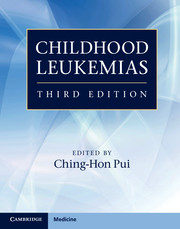Book contents
- Frontmatter
- Contents
- List of contributors
- Preface
- Section 1 History and general issues
- Section 2 Cell biology and pathobiology
- Section 3 Evaluation and treatment
- 12 Pharmacokinetic, pharmacodynamic, and pharmacogenetic considerations
- 13 Acute lymphoblastic leukemia
- 14 Relapsed acute lymphoblastic leukemia
- 15 B-cell acute lymphoblastic leukemia and Burkitt lymphoma
- 16 Acute myeloid leukemia
- 17 Relapsed acute myeloid leukemia
- 18 Myelodysplastic syndrome
- 19 Chronic myeloproliferative disorders
- 20 Leukemias in patients with Down syndrome
- 21 Treatment of adolescents and young adults with acute lymphoblastic leukemia
- 22 Hematopoietic stem cell and natural killer cell transplantation
- 23 Treatment of acute leukemia in countries with limited resources
- 24 Antibody-targeted therapy
- 25 Adoptive cellular immunotherapy
- 26 Gene transfer: methods and applications
- 27 Development therapeutics
- 28 Minimal residual disease
- Section 4 Complications and supportive care
- Index
- Plate Section
- References
15 - B-cell acute lymphoblastic leukemia and Burkitt lymphoma
from Section 3 - Evaluation and treatment
Published online by Cambridge University Press: 05 April 2013
- Frontmatter
- Contents
- List of contributors
- Preface
- Section 1 History and general issues
- Section 2 Cell biology and pathobiology
- Section 3 Evaluation and treatment
- 12 Pharmacokinetic, pharmacodynamic, and pharmacogenetic considerations
- 13 Acute lymphoblastic leukemia
- 14 Relapsed acute lymphoblastic leukemia
- 15 B-cell acute lymphoblastic leukemia and Burkitt lymphoma
- 16 Acute myeloid leukemia
- 17 Relapsed acute myeloid leukemia
- 18 Myelodysplastic syndrome
- 19 Chronic myeloproliferative disorders
- 20 Leukemias in patients with Down syndrome
- 21 Treatment of adolescents and young adults with acute lymphoblastic leukemia
- 22 Hematopoietic stem cell and natural killer cell transplantation
- 23 Treatment of acute leukemia in countries with limited resources
- 24 Antibody-targeted therapy
- 25 Adoptive cellular immunotherapy
- 26 Gene transfer: methods and applications
- 27 Development therapeutics
- 28 Minimal residual disease
- Section 4 Complications and supportive care
- Index
- Plate Section
- References
Summary
Introduction
B-cell acute lymphoblastic leukemia (ALL) accounts for approximately 2% of childhood ALL in the USA. This malignancy has clinical, histologic, immunophenotypic, and cytogenetic features similar to those of Burkitt lymphoma, a high-grade B-cell non-Hodgkin lymphoma. Burkitt lymphoma and B-cell ALL are usually considered to represent a spectrum of the same disease process. In children, the distinction between Burkitt lymphoma with bone marrow involvement and B-cell ALL is arbitrarily based on the degree of bone marrow infiltration. Patients who have less than 25% replacement of normal marrow with lymphoblasts are considered to have advanced (stage IV) Burkitt lymphoma, whereas those with more extensive marrow replacement are assigned the diagnosis of B-cell ALL. These two groups are treated with protocols similar to those used for patients with advanced-stage Burkitt lymphoma that has not disseminated to the marrow (stage III). Although limited-stage Burkitt lymphoma is included in this disease spectrum, it is less common than the advanced forms and is treated with much less intensive therapy. Hence, in describing treatment, we will focus on stages III and IV Burkitt lymphoma and B-cell ALL.
Advances in our understanding of the molecular pathogenesis of these malignancies and improvements in treatment outcome have been striking over the past 25 years. Event-free survival rate can be expected as high as 90% for children with B-cell ALL to date, as opposed to under 50% in the mid 1980s.
- Type
- Chapter
- Information
- Childhood Leukemias , pp. 383 - 394Publisher: Cambridge University PressPrint publication year: 2012
References
- 1
- Cited by



